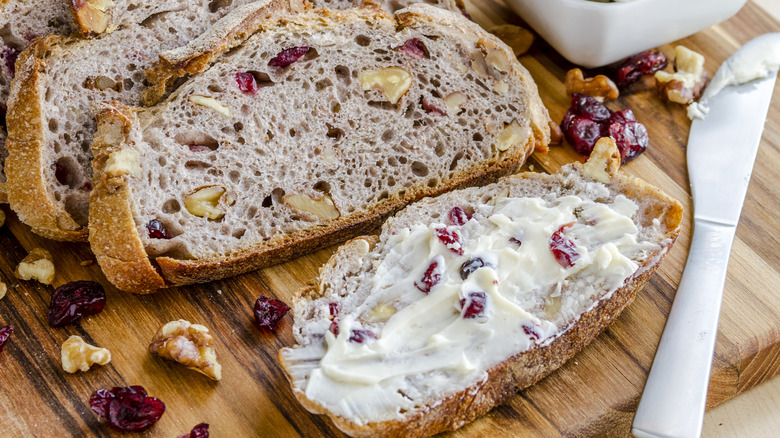What's The Best Kind Of Cranberry To Use For A Holiday Compound Butter?
The holiday season is just around the bend, and what's a better way to celebrate than with food? Along with the holiday favorites of succulent turkey, crispy roasted potatoes, and moist fruitcake, there is one ingredient that deserves a second thought — butter. Sure, it's delicious in its plain store-bought form, but once transformed into a compound butter, it takes on a whole new lease of life. This holiday, add some cranberries to create a compound butter that's decadently sweet and creamy.
The term "compound" might sound technical, but it simply refers to mixing softened butter with other ingredients. With cranberries, it creates a spread that's sweet and tart yet silky and smooth. Ideally, you want to use unsalted butter, as you'll create the most versatile spread (you can always add some salt on top if you want to push it over to savory). It's the perfect addition to a turkey sandwich, a fruity muffin, or spread on a crusty hot roll. Since cranberries are in season from September to November, using the fresh variety in compound butter is a spectacular idea. Fresh cranberries add a burst of bright flavor to your butter as well as a vibrant pink hue.
You can also use frozen or dried cranberries if fresh are unavailable. However, the butter's flavor may alter slightly. Since mixing cranberries into mayonnaise is a genius notion, it only makes sense to fold them into butter as well. Give it a go!
Enter the cranberry universe
Using fresh cranberries in a compound butter will produce a tart spread, and in this case, you may be looking for ways to curb the sharp punch with a bit of sweetness. Brown sugar or honey are fantastic accompaniments, as their smooth, earthy sweetness melds perfectly with the sharp cranberries while effortlessly blending into butter.
Dried cranberries can also be used in compound butter, but you should be aware that sugar (or a sugar alternative) is usually added to sweeten and preserve the berries. Thus, dried cranberries are generally sweeter than fresh. In this case, you may want to rethink adding other sweet ingredients, as the little pockets of cranberry should suffice. Dried cranberries are also a great alternative to bright pink butter. Instead, you have little specks of color that break up the ivory shades.
Frozen cranberries can also be used in compound butter. However, this will require some planning, as you'll need to thaw the cranberries first. Otherwise, as the cranberries have defrosted, you might be met with a butter that's thin and watery.
Another buttery interpretation
While compound butter, by definition, uses butter, other cranberry spreads utilize the flavor and texture of the fruit to create a similar silky consistency. Although these alternatives may resemble a coulis, they have a thicker texture and can be labeled "cranberry butter." Cranberry butter can be made with fresh cranberries, water, and maple syrup and then seasoned with orange juice and cinnamon. You may substitute the maple syrup for brown sugar or introduce apple cider for a little acidity (instead of orange juice). One handy tip: Once you've created this butter, pouring it into sanitized jars and sealing it while it's still hot will prolong its shelf life.
This cranberry butter has a sweet jam appearance with a rich and tarty depth of flavor. It's also as robust as it looks. In other words, a little goes a long way. It's wonderful to stir into oatmeal, served alongside fat slabs of cheese, or even as a glaze for pork or chicken. How you use it is entirely up to you. Whether folded into a compound butter or blended into a fruity spread, one thing is certain. Cranberry butter is a guaranteed way to triumph during the holidays.


